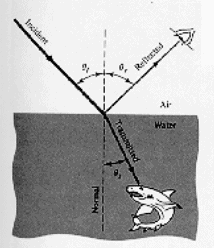
Geometrical Optics



 Refraction
Refraction
|
A beam incident on a transparent medium (glass or water)
is split into a reflected and a transmitted (refracted)
beam. (Remember the bulldozer.)

 Law of Refraction
(Snell's Law) Law of Refraction
(Snell's Law)
| |||||||||||||||||||||||||||||||||||||||||||||||||||||||||||||||||
|
Try it! Refraction
| |||||||||||||||||||||||||||||||||||||||||||||||||||||||||||||||||
|
 Index of Refraction Index of Refraction
n = c/v
Angle of transmission, for various
angles of incidence, and various media
|
|
 Total internal reflection Total internal reflection
Try it! Critical Angle of Reflection
|
 Fiber Optics Fiber Optics
If the fiber is used to transmit a light signal consisting of a rapid series of pulses, it is important not only that all the light from a given pulse reach the other end of the fiber, but that it all arrive there at one time. Otherwise the pulse becomes spread out and might blur with the next pulse. Graded fibers with varying index of refraction can be made so that the time for rayis going straight down the center is the same as for rays bouncing from side to side. Such fibers are replacing metal wire for telephone lines andn for data transmission. In general, the higher the frequency of a wave used for communication, the more information can be transmitted per second. Since the frequency of visible light is much higher than radio frequencies, these fibers can carry many signals (or conversations) at the same time. Further, they do not radiate signals, so they cannot be bugged without directly connecting to them.
|
 Dispersion Dispersion

 Snell's law rephrased Snell's law rephrased
Index of Refraction in Various Media:
|
 Mirages and atmospheric distortions Mirages and atmospheric distortions
A dark asphalt road will get very hot in the summer sun. When this
happens, the air next to it may become much hotter than the higher
air. This, in turn, can cause light to be bent so much that
it appears reflected -- a mirage.
In a rough way one can
think of the effect as a gradual total internal reflection at the
boundary between hot and cool air. When you look at the road
ahead, you see a reflection in it of whatever lies ahead.
The reflections of the sky are mostly associated with the appearance
of water on the road. We can see the sun after it has set below the geometrical horizon. The atmosphere is denser toward the bottom, less dense toward the top. The gradual change in density produces a gradual change in the index of refraction, which bends the light coming from the sun ( figure ). Here is an example of a sunset (Nova Scotia, Canada) .
|

Ch. Elster